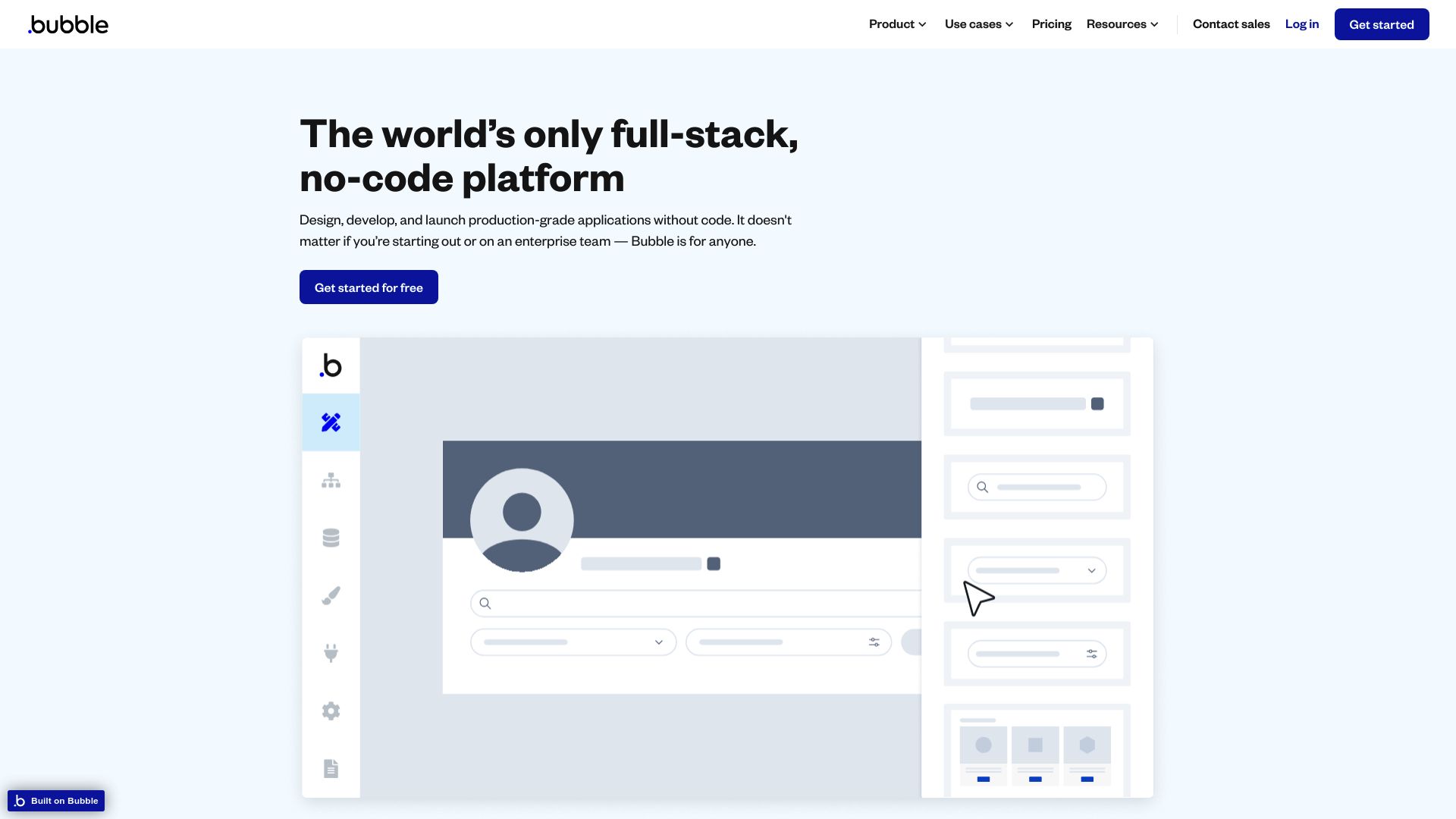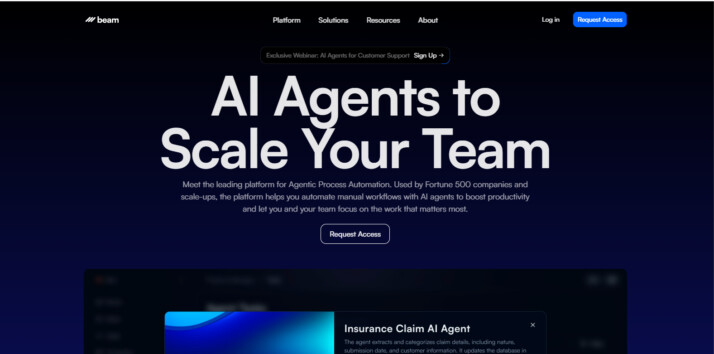Bubble vs. Beam AI: Comparing AI Development Platforms
AI development platforms are transforming how businesses create intelligent applications and automate complex processes. This comparison explores three leading solutions: Bubble, known for its no-code web application builder; Beam AI, which specializes in generative AI agents for task automation; and SmythOS, our comprehensive AI development and deployment platform. We’ll examine how each tool approaches AI integration, ease of use, and scalability, helping you determine which solution best fits your organization’s needs. Whether you’re a developer seeking powerful APIs, a business leader focused on enterprise-grade features, or an entrepreneur looking for accessible AI tools, this review will guide you through the strengths and limitations of each platform.
Bubble Overview
Bubble revolutionizes web application development with its no-code platform. The visual builder empowers users to create complex web apps without writing a single line of code. Drag-and-drop elements, build workflows, and design user interfaces — all through an intuitive visual interface.
Bubble caters to entrepreneurs, small businesses, and enterprises seeking rapid application development. The platform shines in creating marketplaces, social networks, and data-driven applications.


Bubble caters to entrepreneurs, small businesses, and enterprises seeking rapid application development. The platform shines in creating marketplaces, social networks, and data-driven applications. Its flexibility allows for building diverse projects, from simple landing pages to complex SaaS products.
Key features include a visual programming language, database management, and user authentication systems. Bubble integrates seamlessly with popular services through its extensive plugin ecosystem. The platform supports AI integration, enabling chatbots, content generation, and image processing capabilities within applications.
Bubble’s scalable infrastructure, built on Amazon Web Services, ensures applications can grow with user demands. The platform offers both development and production environments, facilitating testing and seamless deployment. While Bubble excels in web application development, it lacks some advanced AI agent capabilities found in specialized platforms.
Beam AI Overview
Beam AI specializes in developing generative AI agents that automate repetitive tasks, boosting productivity for organizations. Their Agentic Process Automations (APAs) perform tasks faster and more cost-effectively than humans in areas like data extraction, customer inquiry management, and compliance automation. These agents continuously learn, improving precision and efficiency over time.


Beam AI specializes in developing generative AI agents that automate repetitive tasks, boosting productivity for organizations.
The platform focuses on back-office automation, customer service, compliance, and order processing. Beam AI’s solutions are tailored to meet specific organizational needs, emphasizing sustainability by minimizing steps and reducing human carbon footprint. The company values speed, designing automation solutions to save time and enhance efficiency.
Beam AI’s agents feature advanced conversational interfaces for seamless interaction and efficient task management. They integrate with existing internal systems to plan and execute workflows, providing comprehensive automation. The company’s vision centers on creating a sustainable and ethical future using AI, with a mission to build agents capable of tackling complex workflows and improving through continuous learning.
Beam AI stands out for its AI-native approach, basing all solutions on artificial intelligence. However, it lacks some features found in more comprehensive platforms. While Beam AI excels in specific automation tasks, it doesn’t offer the breadth of development tools, such as visual builders or no-code options, that some competitors provide. This may limit its appeal to users seeking a more hands-on development experience or those requiring extensive customization options.
Beam AI stands out for its AI-native approach, basing all solutions on artificial intelligence. However, it lacks some features found in more comprehensive platforms.
The platform’s focus on specific use cases like back-office automation and customer service makes it a strong choice for businesses prioritizing these areas. However, organizations looking for a more versatile toolkit for AI development across various domains might find Beam AI’s offerings somewhat narrow. The company’s commitment to continuous improvement and adaptation in AI technology positions it well for future growth, but current limitations in features like multi-agent collaboration or extensive debugging tools might be considerations for potential users.
Feature Comparison
Bubble and Beam AI take different approaches to AI development and automation. Bubble shines with its visual, no-code platform for building web applications, while Beam AI focuses on developing specialized AI agents for task automation.
Bubble’s strength lies in its intuitive drag-and-drop interface, enabling users to create complex web applications without coding. It supports integrating AI functionalities through APIs and plugins, allowing developers to enhance applications with AI capabilities like chatbots and recommendation engines. Bubble provides both development and production environments, facilitating testing and deployment. However, Bubble lacks specific features for hosting AI agents or supporting autonomous AI operations.
In contrast, Beam AI specializes in developing generative AI agents for automating repetitive tasks. Their Agentic Process Automations (APAs) excel in areas like data extraction, customer inquiry management, and compliance automation. Beam AI’s agents continuously learn and improve, enhancing precision and efficiency over time. While Beam AI offers advanced AI capabilities, it doesn’t provide the visual building tools or no-code options that Bubble does, potentially limiting its accessibility to non-technical users.
Both platforms have gaps in core components and security features compared to more comprehensive solutions. Neither offers extensive explainability tools or built-in multi-agent collaboration capabilities. Bubble provides some security measures like data encryption and OAuth support, but lacks advanced features like IP control. Beam AI’s security offerings are not explicitly detailed in the provided information, highlighting a potential area for improvement in both platforms.
Feature Comparison Table
| Bubble | Beam AI | SmythOS | |
|---|---|---|---|
| CORE FEATURES | |||
| Visual Builder | ✅ | ❌ | ✅ |
| No-Code Options | ✅ | ❌ | ✅ |
| Memory & Context | ❌ | ✅ | ✅ |
| Autonomous Agents | ❌ | ✅ | ✅ |
| Explainability & Transparency | ❌ | ✅ | ✅ |
| Debug Tools | ✅ | ❌ | ✅ |
| Multimodal | ❌ | ❌ | ✅ |
| Multi-Agent Collaboration | ❌ | ✅ | ✅ |
| Bulk Work | ❌ | ✅ | ✅ |
| Agent Work Scheduler | ❌ | ✅ | ✅ |
| SECURITY | |||
| Constrained Alignment | ❌ | ✅ | ✅ |
| IP Control | ❌ | ✅ | ✅ |
| COMPONENTS | |||
| Huggingface AIs | ❌ | ✅ | ✅ |
| Classifiers | ❌ | ✅ | ✅ |
| Data Lakes | ✅ | ❌ | ✅ |
| DEPLOYMENT OPTIONS (EMBODIMENTS) | |||
| Deploy as API | ❌ | ✅ | ✅ |
| Deploy as Scheduled Agent | ❌ | ✅ | ✅ |
| DATA LAKE SUPPORT | |||
| Hosted Vector Database | ❌ | ❌ | ✅ |
| Sitemap Crawler | ❌ | ❌ | ✅ |
| YouTube Transcript Crawler | ❌ | ❌ | ✅ |
| URL Crawler | ❌ | ❌ | ✅ |
Best Alternative to Bubble and Beam AI
SmythOS stands out as the superior agentic AI automation platform, offering a comprehensive solution that surpasses both Bubble and Beam AI. Our platform combines the best of both worlds, providing an intuitive drag-and-drop interface for building complex AI workflows without sacrificing advanced capabilities.
We excel in ease of use, offering a visual builder and no-code options that make AI development accessible to users of all skill levels. Unlike Bubble’s limited AI integration capabilities or Beam AI’s specialized focus, SmythOS supports a wide range of use cases, from simple chatbots to complex multi-agent systems.
SmythOS stands out as the superior agentic AI automation platform, offering a comprehensive solution that surpasses both Bubble and Beam AI.
Our feature set is unparalleled. We offer autonomous agents with memory and context capabilities, ensuring intelligent and contextually aware interactions. SmythOS provides robust explainability and transparency tools, addressing a critical gap in both Bubble and Beam AI’s offerings. This allows users to understand and trust the decision-making processes of their AI agents.
SmythOS shines in its deployment flexibility. We support a variety of deployment options, including APIs, webhooks, scheduled agents, and integration with popular platforms like ChatGPT. This versatility ensures that our AI solutions can be seamlessly incorporated into existing workflows and systems, a capability neither Bubble nor Beam AI can match comprehensively.
Perhaps most importantly, SmythOS is built for scalability and performance. We provide enterprise-grade features like data encryption, OAuth support, and IP control, coupled with a hosted vector database for efficient data management. These capabilities position SmythOS as the ideal choice for businesses looking to leverage AI at scale, offering a level of robustness and security that surpasses both Bubble and Beam AI.
Conclusion
Bubble and Beam AI each offer unique approaches to AI development and automation, but SmythOS emerges as the superior choice for businesses seeking comprehensive AI solutions. Bubble excels in no-code web application development, while Beam AI focuses on specialized AI agents for task automation. However, both platforms have limitations that SmythOS addresses.
SmythOS combines the best of both worlds, offering an intuitive drag-and-drop interface for creating complex AI workflows without extensive coding knowledge. Our platform supports a vast array of AI models and integrations, allowing users to build sophisticated multi-agent systems that can tackle complex tasks across various domains. Unlike Bubble and Beam AI, SmythOS provides robust features for hosting agents, debugging, and explanability, ensuring transparency and control in AI operations.
We pride ourselves on our versatile deployment options, enabling users to integrate AI solutions seamlessly into existing systems. Whether you need to deploy as an API, webhook, site chat, or even as a ChatGPT plugin, SmythOS has you covered. Our platform’s scalability and security features, including data encryption and OAuth support, make it ideal for businesses of all sizes, from startups to large enterprises.
Ready to experience the future of AI development? Create a free SmythOS account today and start building powerful AI agents with our user-friendly platform. With our 30-day money-back guarantee, you can explore the full potential of SmythOS risk-free. Discover our extensive library of AI agent templates to jumpstart your projects and revolutionize your workflow. Join the AI revolution with SmythOS – where innovation meets simplicity.
Last updated:
Disclaimer: The information presented in this article is for general informational purposes only and is provided as is. While we strive to keep the content up-to-date and accurate, we make no representations or warranties of any kind, express or implied, about the completeness, accuracy, reliability, suitability, or availability of the information contained in this article.
Any reliance you place on such information is strictly at your own risk. We reserve the right to make additions, deletions, or modifications to the contents of this article at any time without prior notice.
In no event will we be liable for any loss or damage including without limitation, indirect or consequential loss or damage, or any loss or damage whatsoever arising from loss of data, profits, or any other loss not specified herein arising out of, or in connection with, the use of this article.
Despite our best efforts, this article may contain oversights, errors, or omissions. If you notice any inaccuracies or have concerns about the content, please report them through our content feedback form. Your input helps us maintain the quality and reliability of our information.
